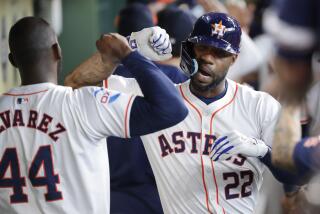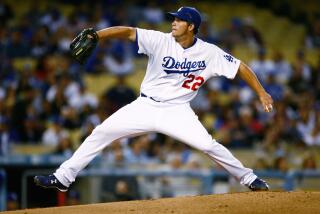The Stopper: : The A’s Gambled on Trade With Yankees for Jay Howell and Came Up Big Winners
OAKLAND — At 6 feet 3 inches and 205 pounds--blond, blue-eyed and baby-faced--Jay Canfield Howell resembles a larger Robert Redford playing Roy Hobbs in “The Natural.”
The similarity is there even as Howell prepares to save another game for the Oakland A’s, his eyes taking on the same look of penetrating determination that Hobbs displayed as he prepared to save the Knights for Pop Fisher.
“Every time I go out to talk to Jay on the mound, he reminds me of a pit bulldog,” A’s catcher Mike Heath was saying the other day. “He has the same blood in his eye that a pit bull gets when he corners a hog. He cares about what happens but he doesn’t care who the hitter is. You’ve got to love his aggressiveness.”
Anything less and Howell would not be making his All-Star debut tonight as a member of the American League’s pitching staff.
Anything less and Howell would not have 18 saves, one fewer than Detroit’s Willie Hernandez, the league leader. Nor would he have an 8-3 record, a 2.00 earned-run average and a strong hand in 56% of the A’s 46 wins--the 18 saves and 8 wins--that made Oakland a surprising second in the West.
Jay Howell, at 29, has needed all of his pit-bull tenacity.
Consider:
--Although never previously cast in the role of stopper or finisher, Howell was tabbed to replace Bill Caudill and his 36 saves when Caudill was traded to Toronto for shortstop Alfredo Griffin and left fielder Dave Collins.
--That trade followed, and was contingent on, the A’s acquisition of Howell in a package deal that sent offensive dynamo Rickey Henderson to the New York Yankees.
Pressure?
“Nah,” Howell said with a grin as he sat at his locker the other day. “I tell people that the A’s traded Bert Bradley for me.”
Which they did.
The trade with the Yankees was minor league pitcher Bradley and the renowned Henderson for Howell, pitching prospects Tim Birtsas, Jose Rijo and Eric Plunk, and outfielder Stan Javier.
The trades were completed Dec. 8 and were made, in part, because both Caudill and Henderson would have been eligible for free agency when the 1985 season ended.
Henderson’s 1984 attitude had troubled Oakland ownership, which had also encountered financial troubles with the parent Levi Strauss Co. The A’s questioned their ability to re-sign Henderson and Caudill, as well as the wisdom of doing so.
It was decided to get something for them, rather than have them leave on their own. The goal was to acquire three or four players who would have an immediate impact and three or four for the future.
Now, halfway through the 1985 season, everyone involved seems satisfied.
Henderson, who got a five-year, $8.5-million contract from the Yankees, has been the anticipated catalyst in a powerful lineup. Caudill, who got a five-year, $7-million contract from Toronto, has helped rehabilitate a weak bullpen.
The A’s, in turn, have received significant help from Howell, Griffin and Collins, and remain confident that Birtsas, Rios and Plunk are future stars.
The key, though, was Howell.
The A’s had no other options in their bid to replace Caudill and complete the trades. Howell represented a gamble.
Not only had he never been a finisher, he had never enjoyed a successful major league season before turning to relief in 1984 and emerging as the setup man for the Yankee relief ace, Dave Righetti.
Howell made 61 appearances last season, 60 in relief. He was 9-4 with 7 saves and a 2.69 ERA. He was 8-0 with 6 saves after June 12, and his total of 109 strikeouts in 103 innings enabled him to lead the league with a ratio of 1.05 strikeouts per inning.
“We were impressed with the numbers,” A’s General Manager Sandy Alderson said the other day.
“We felt that if he had the fortitude, the intangibles, he certainly had the tangibles.”
Among those with doubts was Billy Martin, with whom Howell has had a love-hate relationship.
Martin had been Howell’s manager in 1983. He was scouting for the Yankees at the time of the trades, having also formerly managed the A’s.
“Billy told us that Howell didn’t have the guts to close a game and advised us to turn him over right away,” said an Oakland executive, requesting anonymity.
“Billy tends to make judgments like that, and we knew from our own experience with him that sometimes he can be right and sometimes he can be wrong.”
According to the executive, the acquisition of Howell was followed by a number of trade offers from teams interested in him, helping convince the A’s that Martin was wrong.
So has Howell’s performance, of course.
Said Bill Rigney, the former manager of the Angels, San Francisco Giants and Minnesota Twins who is now an adviser to the A’s: “It’s a little different when you’ve got a Righetti or Goose Gossage behind you. The pressure is on the other guy. You can free-wheel it. Howell had never closed it. He came here naked, but he’s done a hell of a job.”
General manager Alderson agreed.
“It’s a testimony to what Jay has done that we’ve not taken any criticism for trading Henderson,” he said. “I mean, when you look at the type year Henderson is having, it’s put a pretty heavy burden on Jay, but he’s definitely handled it.”
The son of John (Cotton) Howell, a tight end with the San Francisco 49ers in the late ‘40s, Howell was attending the University of Colorado when selected in the 31st round of the 1976 amateur draft.
The most memorable of the five appearances he made as a rookie with the Cincinnati Reds in 1980 was his August debut against the Dodgers. He bounced a fastball off Steve Garvey’s batting helmet, had a shouting match about it with Dodger Manager Tom Lasorda, then struck out Ron Cey and got Rudy Law to ground into a game-ending double play, preserving a 9-1 win.
He was traded to the Cubs for catcher Mike O’Berry at the end of that season and spent most of 1981 at Iowa. There, a year later, he was 13-4, prompting the Yankees to give the Cubs infielder Pat Tabler for Howell and a relief pitcher named Caudill, whom they immediately traded to Seattle for pitcher Shane Rawley and outfielder Bobby Brown.
Reflecting on those early years, Howell said that in no way was he ready to become the pitcher he is now.
“I stunk,” he said. “The scouts who said I had a good arm but no idea what I was doing out there were right.”
His 1983 season was both pivotal and miserable. He spent the entire season in the majors, for the first time, making 19 appearances, 12 as a starter. His 1-5 record was capped by August knee surgery.
The toughest part was dealing with Martin, who second-guessed his pitch selection, criticized his high-kick delivery that allowed runners to steal at will and ultimately let Howell sit for weeks at a time.
“Billy would say he was tired of looking at me, and crazy if he put me out there,” Howell said. “I didn’t like his methods but I know now he was right about a lot of things. I was being stupid, dumb. I was pitcher of the year in the minors the year before, and I figured I didn’t have to change anything.”
Howell changed his mind, though, in the Puerto Rico Winter League at the end of the 1983 season. He adjusted his kick, depriving runners of their easy jump.
He went to spring training under a new manager, Yogi Berra, and had an impromptu conversation with Baltimore’s Jim Palmer before a Florida exhibition that clarified some of the same points Martin had attempted to make.
Palmer convinced Howell that he had been pitching backwards, telling him that any pitcher blessed with a fastball ranging from 90 to 92 m.p.h. had to make hitters aware of it early, employing it to set up his curve or slider, rather than the other way around.
Howell responded by consistently getting ahead in the count rather then having to groove his fastball to hitters waiting for it with the count in their favor.
“He has a great fastball and a good slider,” catcher Heath said. “I don’t think anyone can hit him when his curve is on.”
Everything came together as Howell frequently pitched the sixth and seventh innings last season, setting up Righetti. Fun and games, Howell said. Then he added: “The only way we thought it would end was if Dave moved back to the rotation and I took his place as the finisher. Dave was hoping that would happen.”
Instead, Howell took Caudill’s place. He got the news on TV while sitting in an empty house that he and his wife had just bought near the Yankees’ training base in Fort Lauderdale, Fla. When the A’s finally reached him, Howell thought about Henderson’s popularity and asked, “Do you think I’ll be safe from the fans?”
Then he realized: “Hey, the A’s have shown a lot of confidence in me. They’ve paid me a compliment. I’m going to prove they made a right decision. I’ve never been a finisher, but I’m not going to start doubting myself. I’m not going to go into the season worrying about it. Let others do that. I’m going to be as aggressive as I was last year. I know what kind of player Henderson is, but the papers are saying that the Yankees stole him, that the trade was all one-sided, and that’s not fair.”
Howell has proved it, producing his 18 saves in 21 opportunities. The eccentricities found in Caudill and other relief pitchers are channeled into pit-bull energy. Meanness, Howell said. An intensity that leaves him jittery while waiting for the bullpen phone to ring.
“I’m not a scientist out there,” he said. “I’m not a finesse pitcher. I don’t paint corners. I don’t have the feeling of power that a Gossage or Ryan or Gooden has, but that’s the way I have to go about it. I’m one-dimensional. I give my best. If that’s not good enough, then I have to be like the salesman who blows a sale. I have to come back the next time a little meaner, a little better.”
Said his pitching coach, Wes Stock: “Jay is kind of quiet, but he’s got that wild look about him. He’s fearless. He challenges everybody.”
Including, in a roundabout way, the man for whom he was traded. Rickey Henderson was the league’s player of the month for June, but Jay Howell was June’s pitcher of the month.
“And the thing about that is that we also got four more players and a lot more money in the bank,” Alderson said, smiling.
More to Read
Go beyond the scoreboard
Get the latest on L.A.'s teams in the daily Sports Report newsletter.
You may occasionally receive promotional content from the Los Angeles Times.










